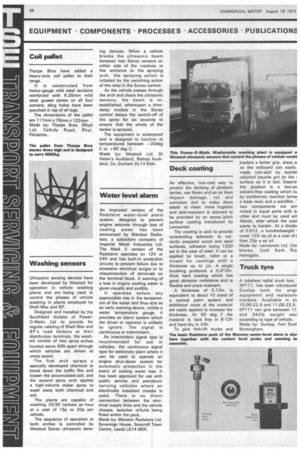Washing sensors
Page 58

If you've noticed an error in this article please click here to report it so we can fix it.
Ultrasonic sensing devices have been developed by Westool for operation in vehicle washing plants and are being used to control the phases of vehicle washing in plants employed by Shell-Max and BP.
Designed and installed by the Southfield division of Power0-Matic Ltd to provide for regular valeting of Shell-Max and BP's road tankers at their distribution terminals, the washers consist of two spray arches located some 50ft apart through which vehicles are driven at creep speed.
The first arch sprays a specially developed chemical to break down the traffic film and loosen the accumulated soil, and the second spray arch applies a high-volume water spray to wash away both chemical and soil.
The plants are capable of washing 25/30 tankers an hour at a cost of 15p to 20p per vehicle.
The sequence of operation at both arches is controlled by Westool Sonac ultrasonic sens
ing devices. When a vehicle breaks the ultrasonic beam between two Sonac sensors on either side of the roadway at the entrance to the spraying arch, the spraying action is initiated by the switching action of the relay in the Sonac control.
As the vehicle passes through the arch and clears the ultrasonic sensors, the beam is reestablished, whereupon a timedelay module in the Sonac control delays the switch-off of the spray for six seconds to ensure that the whole of the tanker is sprayed.
The equipment is waterproof and is designed to function at temperatures between —20deg C to +60 deg C.
Made by: Westool Ltd, St Helen's Auckland, Bishop Auckland, Co. Durham DL14 9AA.


































































































